Trees Birds Mammals Fish Amphibians Reptiles
Wild Algarve
Bookshop
Guepinia helvelloides (DC.) Fr. - Salmon Salad
Phylum: Basidiomycota - Class: Agaricomycetes - Order: Auriculariales - Family: insertae sedis
Distribution - Taxonomic History - Etymology - Identification - Culinary Notes - Reference Sources
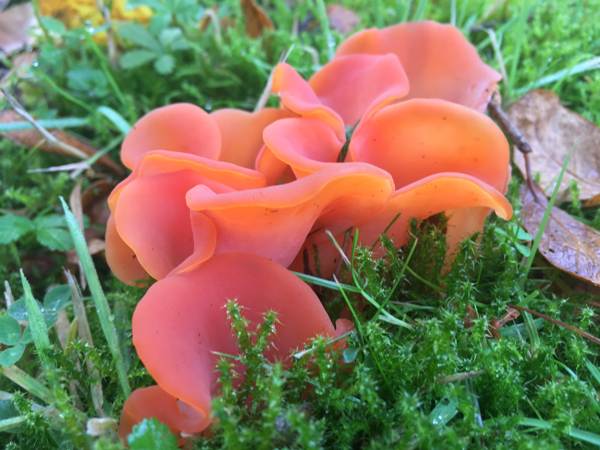
Mainly seen in summer and autumn, Salmon Salad is an instantly recognisable fungus, even though fruitbodies vary greatly in shape and size. Its jelly-like (but rubbery) texture and strking colouring are unlikely to be confused with any other fungus species. The so-called Jelly Fungi are not really a taxonomic group but more a rag-tag of basidiomycetes with jelly-like textures, although few are as soft as the jelly we eat with custard.
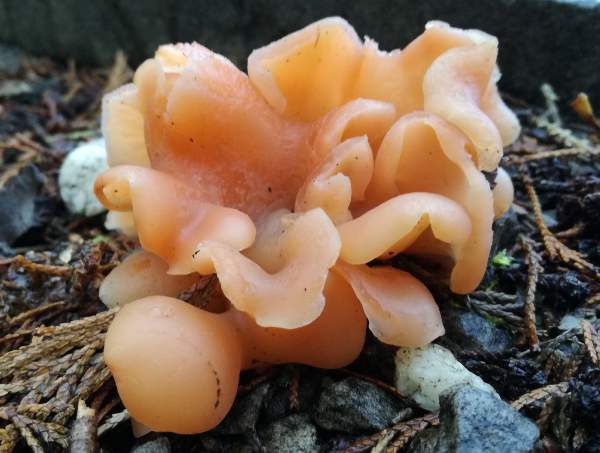
Distribution
An occasional find in Britain, but quite often recorded in South Wales and i9n parts of Devon, Salmon Salad fungus occurs also in many countries of mainland northern and central Europe and is recorded occasionally in temperate parts of North America, South America and Asia.
Taxonomic history
Salmon Salad fungus was first described scientifically in 1778 by Dutch botanist Nicolaus Joseph von Jacquin (1727 - 1817), who gave it the binomial scientific name Tremella rufa. It's currently-accepted scientific name dates from Elias Magnus Fries' Systema mycologicum of 1828.
Synonyms of Guepinia helvelloides (DC.) Fr. include Tremella rufa Jacq., Tremella helvelloides DC., Tremiscus helvelloides (DC.) Donk, , Guepinia rufa (Jacq.) Beck, Gyrocephalus helvelloides (DC.) Keissl., Gyrocephalus rufus (Jacq.) Bref., Phlogiotis helvelloides (DC.) G.W. Martin, and Phlogiotis rufa (Jacq.) Quél.
Guepinia helvelloides is
the type species of its genus, which currently contains just this one species (and therefore the genus Guepinia is referred to as being monotypic). Some authorities place the genus Guepinia within the family Exidiaceae, but like many others we have left it as uncertain and unresolved (insertae sedis).
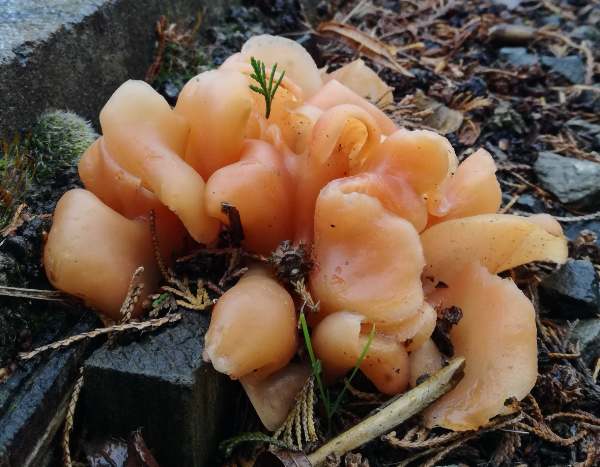
Etymology
The genus name Guepinia, established by the great Swedish mycologist Elias Magnus Fries, honours French mycologist and botanist Jean Pierre Guépin (1779-1858). The specific epithet helvelloides means 'looking like a Helvella' - see for example the ascomycete Helvella crispa, whose curly caps are usually more contorted than those of Guepinia helvelloides. (Helvella is an ancient term for a curly-leaved aromatic herb.)
Other common names that have been given to this species include Apricot Jelly, and Red Jelly Fungus.
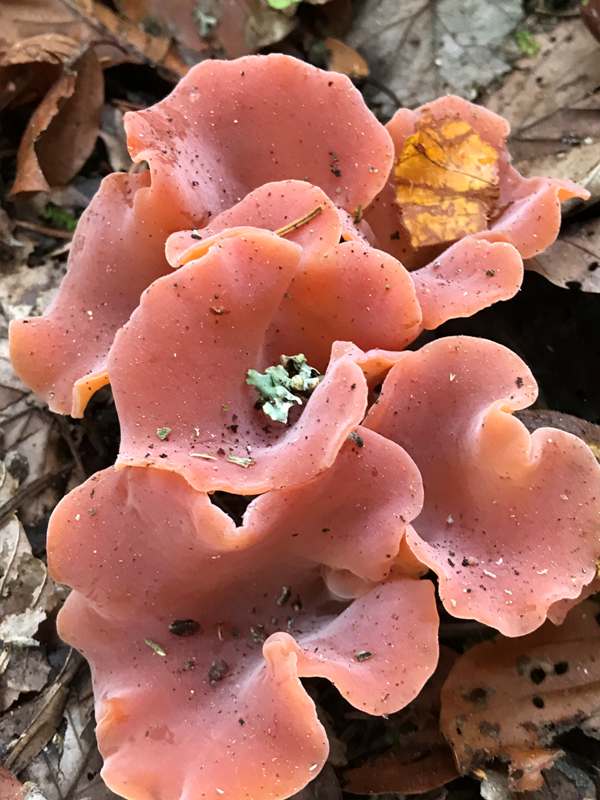
Identification guide
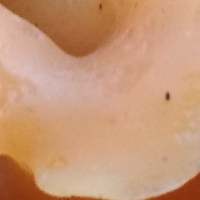
|
Fruitbody
Eccentric and usually deeply split and distorted funnels, often tongue-like, growing in tufts. Individual fruitbodies are 4-10cm tall and 4-15cm wide, with no clear delineation between cap and stem; cap flesh 2-3.5mm thick, flexible, soft and rubbery.
The inner (largely infertile) surface is smooth, apricot to salmon pink or orange. (Albino forms of this fungus are occasionally reported.) |
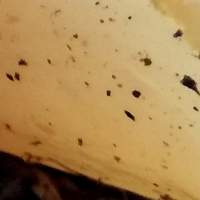 |
The fertile outer surface (underside of the funnel) is smooth and generally a paler shade of apricot to salmon pink, fading to almost white towards the finely tomentose stem base that is typically 1.5cm in diameter. |
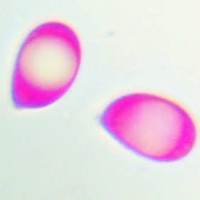 |
Spores
Ellipsoidal to cylindrical, smootyh, 9-11 x 5-6μm; hyaline; containing a large oil drop.
Spore print
White. |
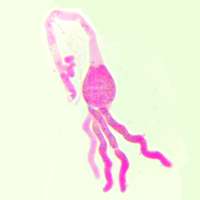 |
Basidia
Four-celled (septate) hypobasidia are cruciate when viewed from the top, ovoid to ellipsoidal, 12-16 x 9-12μm. Four elongate epibasidia 20-45 x 3-4μm arise from each hypobasidium. (This is a feature found in fungi of the Auriculariales and Tremellales orders.) The overall appearance is rather squid-like!
Ellipsoidal to cylindrical, smootyh, 9-11 x 5-6μm; hyaline; containing a large oil drop.
|
Odour/taste |
Not significant. |
Habitat & Ecological role |
Saprobic, usually growing in scattered small tufts on buried dead timber. |
Season |
Guepinia helvelloides can be found throughout the year, but it is most prevalent in late
summer and autumn. |
Similar species |
Auricularia auricula-judae, commonly known as Jelly Ear Fungus, is similar in texture but is much browner, more contorted in shape, and nearly always found above ground on dead Elder.
Pleurocybella porrigens, commonly known as Angel's Wings, is similar in shape but it is less flexible and has a gilled hymenial surface.
Lentinellus cochleatus, commonly known as Aniseed Cockleshell, is similar in shape and texture and sometimes also in colour but it has a gilled hymenial surface. |
Culinary Notes
Widely reported to be edible but very bland and of little or no culinary value.
Reference Sources
Fascinated by Fungi, 2nd Edition, Pat O'Reilly 2016, reprinted by Coch-y-bonddu Books in 2022.
Fries E. M. (1828). Elenchus Fungorum.
Dictionary of the Fungi; Paul M. Kirk, Paul F. Cannon, David W. Minter and J. A. Stalpers; CABI, 2008
Taxonomic history and synonym information on these pages is drawn from many sources but in particular from the British Mycological Society's GB Checklist of Fungi.
Acknowledgements
This page includes pictures kindly contributed by Simon Harding, Carol Lines and Jane Steere.
Top of page...
Fascinated by Fungi. Back by popular demand, Pat O'Reilly's best-selling 450-page hardback book is available now. The latest second edition was republished with a sparkling new cover design in September 2022 by Coch-y-Bonddu Books. Full details and copies are available from the publisher's online bookshop...